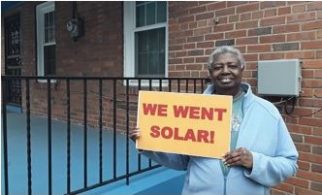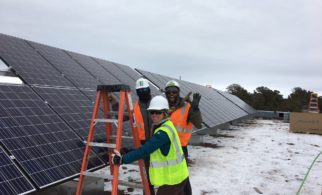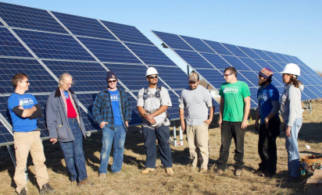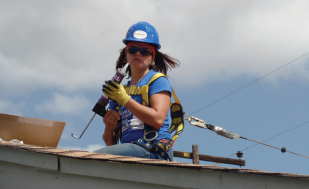Consumer Protection
Guiding principles: Consumer Protection
Barrier addressed: Market Forces
Entering into a contract for solar, whether under a leasing arrangement, a purchase, or an interest in a community solar project, is an important decision. As with other significant financial transactions, consumers should understand what they are agreeing to and not be subject to unfair, abusive, or deceptive practices. Low-income solar programs should be designed to protect consumers from financial arrangements that may be too risky, with an eye toward maximizing household savings.
At the outset, low-income program design should recognize the existence of state and federal consumer protection laws, and should emphasize the need for robust enforcement of those existing laws. Additionally, program design should emphasize consumer education, with a requirement for solar providers to engage in a clear review of the substantive terms of the agreement with their customers. Review of key terms should include, among other things, provisions relating to the term of the agreement, Renewable Energy Credit allocation, contract termination, fees, and rate escalators or assumptions.
Depending on program design and need, a low-income solar program may include a process for registering solar providers who have met minimum criteria for program participation. Pre-certification of solar providers may be useful for overcoming customer skepticism, while rewarding providers who have proven to be reliable businesses. If program design does not include pre-certification, consumer protection provisions should encourage customers to fully vet their potential solar providers.
Program design should include robust stakeholder input to identify the specific consumer protection measures required, which may vary by jurisdiction. Some examples of consumer protection measures in program design are found below:
- Issued April 7, 2014, the Minnesota Public Utilities Commission (MPUC) Order Rejecting Xcel’s Solar-Garden Tariff Filing and Requiring The Company to File a Revised Solar-Garden Plan (pg. 28-30) lists the subscriber-protection measures that the tariff and contract between Xcel and the solar-garden operator must include. The required subscriber-protection measures, link to the MPUC Order, and other resources are found here.
- Issued January 30, 2015, the California Public Utilities Commission (CPUC) instituted minimum consumer protection standards in its Order Instituting Rulemaking Regarding Policies, Procedures and Rules for the California Solar Initiative, the Self-Generation Incentive Program and Other Distributed Generation Issues. The Program Administrator of the Single-Family Affordable Solar Homes (SASH) Program was required to adopt these minimum standards as part of its third-party ownership (TPO) model. The minimum standards and link to the CPUC Order are found here.
- Effective July 18, 2016, the Maryland Public Service Commission included consumer protection requirements in the state’s 3 year Community Solar Energy Generating Systems (CSEGS) pilot program. The measures and link to the regulations are found here.
Organizations like the Interstate Renewable Energy Council (IREC) and the Solar Energy Industries Association (SEIA) provide additional resources related to consumer protection. The Better Business Bureau and state or city contracting boards are good resources for information about local providers.
Bill Savings Requirements and Verification Examples
An extremely important aspect of consumer protection in low-income solar programs is ensuring customers are receiving tangible economic benefits from the outset. This also helps ensure that low-income customers are motivated to participate — getting large-scale participation for this customer segment typically requires a higher level of financial savings. Many, but not all, successful low-income solar programs have built in minimum savings requirements and mechanisms for enforcement. Below are a few program examples.
California Single Family Affordable Solar Housing Program
California’s Single Family Affordable Solar Housing (“SASH”) program provides solar for low-income households at no cost to the household.1 The statewide program administrator for SASH ensures that all systems are cash-flow positive from day one. Incentives are deliberately set at a level to cover a significant percentage of the system cost. Any gaps in financing between the available incentive and the system cost are filled by the program administrator, a non-profit organization that contributes proceeds from a third-party ownership (TPO) arrangement and its own philanthropic fundraising to projects. The SASH TPO model, by design, removes all financial liability for the low-income family, thereby allowing families with poor credit to participate. The SASH program’s TPO model must meet 12 baseline consumer protection minimum standards, including ensuring customers receive at least 50% of the savings, as compared to standard utility rates, from the solar generating equipment. In practice, the minimum 50% savings is a “floor,” as most SASH households participating in the TPO model realize 80% savings or higher.2
California Solar on Multifamily Affordable Housing Program
In December 2017, California issued a Decision Adopting Implementation Framework for Assembly Bill 693 and Creating the Solar on Multifamily Affordable Housing Program (“SOMAH”).3 Consistent with AB 693, the new SOMAH program will provide incentives for the installation of solar distributed generation projects sited on existing multifamily affordable housing. The Decision doesn’t have a mandatory bill reduction percentage, but the Decision does have a requirement that tenants receive 100% of the economic benefits of the virtual net metering (“VNEM”) credits allocated to them:
“In order to protect tenants from bearing any additional costs through increased rents, adjustments to utility allowances, or other mechanisms, we direct the PA [Program Administrator] to establish the appropriate documentation requirements, to be included in their proposed SOMAH Program Handbook, for applicants to demonstrate that 100% of the economic benefits of the generation system will be reserved for tenants through the life of the system.”4
To motivate participation by housing owners, the incentive levels for the portion of the system allocated to tenant meters has been set high enough to cover most or all of the cost, so that the tenants receive the economic benefits at little or no additional financial burden for the housing owner. Properties will receive lower, but still significant, incentives for portions of the system dedicated to common spaces.
District of Columbia Solar for All
Washington D.C.’s Solar for All program sets specific targets to provide the benefits of solar electricity to 100,000 low-income households (at or below 80% Area Median Income), and to reduce their energy bills by 50% (based on the 2016 residential rate class average) by 2032.5 Solar for All includes single-family, multifamily, and community solar projects.
Colorado Low-Income Community Shared Solar Demonstration Project
The Colorado Energy Office’s Low-Income Community Shared Solar Demonstration Project provided no-cost community solar subscriptions to low-income residents in rural electric cooperative territories and included a target to bring customers within an average state energy burden, as summarized on page 4 of the project report.6 Of the eight projects, six projects had 50% Targeted Cost Savings as Percentage of Utility Bill, one project had 30% and one project had 15-50%.7
Colorado Low-Income Rooftop Solar Pilot
The Colorado Energy Office Rooftop Solar Demonstration Pilot also offers an innovative example of consumer protection through minimum savings targets. In the case of this program, which is implemented through the Colorado Weatherization Assistance Program (“WAP”), the State must demonstrate that the PV investments are cost-effective for customers, defined as exceeding a Savings-to-Investment Ratio (“SIR”) of 1 or greater, a federal requirement of the WAP program. The Colorado Energy Office has found that energy efficiency measures paired with solar – providing low-income households access to a long-term net metering benefit – can far exceed the SIR for efficiency alone. More detail about this approach can be found in NREL’s report.
Illinois Solar for All Program
With Illinois Solar for All, participants will see no upfront costs and ongoing costs and fees will not exceed 50% of the value of the energy generated from that system.8 Savings is calculated by dividing the total cost and fees charged to a customer by the value of the energy produced by the system in the first year (all on an annual basis), and then subtracting that fraction from 100%.
Annual Customer Payment ÷ 1st Year Net Metering Value < 0.5
The Program Administrator will track these metrics to ensure benefits are being experienced.
1 http://www.cpuc.ca.gov/General.aspx?id=3043
2 Issued January 30, 2015, the California Public Utilities Commission Order Instituting Rulemaking Regarding Policies, Procedures and Rules for the California Solar Initiative, the Self-Generation Incentive Program and Other Distributed Generation Issues (pg. 79-80) lists the minimum standards the program administrator had to meet in California when a third-party ownership (TPO) model was adopted under the Single Family Affordable Solar Homes (SASH) program. Source: California Public Utilities Commission Rulemaking 12-11-005/Decision 15-01-027 http://docs.cpuc.ca.gov/PublishedDocs/Published/G000/M145/K938/145938475.PDF
3 http://docs.cpuc.ca.gov/PublishedDocs/Published/G000/M201/K135/201135758.pdf
4 Decision p. 20/21
5 https://doee.dc.gov/solarforall
6 https://www.colorado.gov/pacific/energyoffice/community-solar
7 https://www.colorado.gov/pacific/sites/default/files/Insights%20from%20the%20CEO%20Low-Income%20Community%20Solar%20Demonstration%20Project.pdf (see TABLE 1: OVERVIEW OF PROJECTS)






